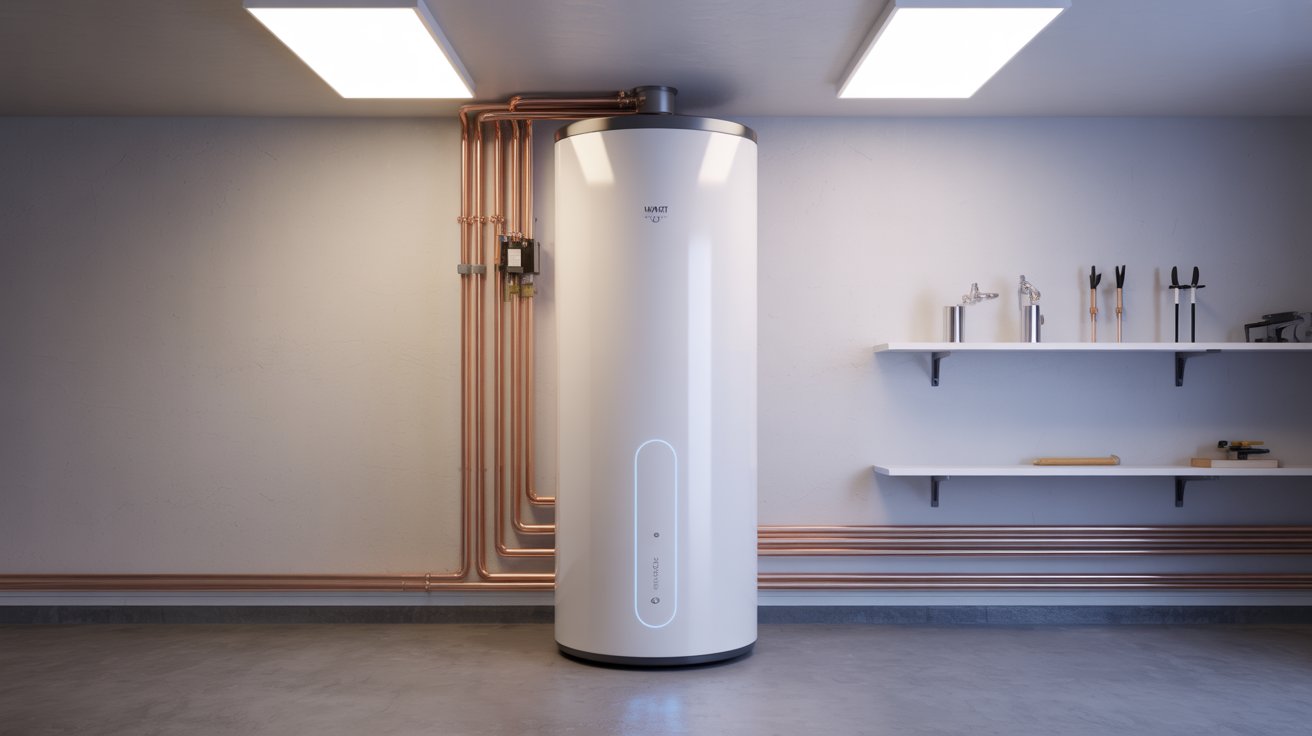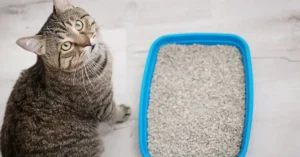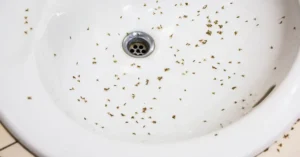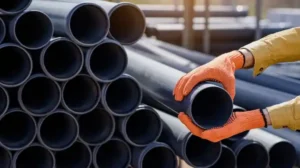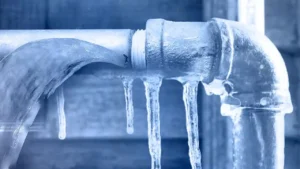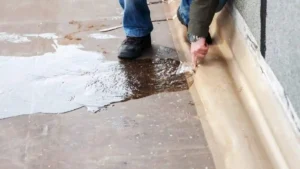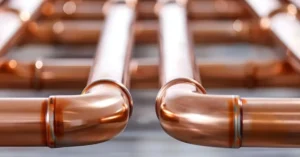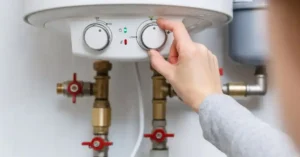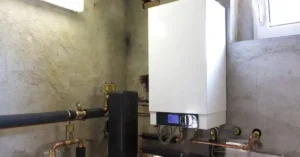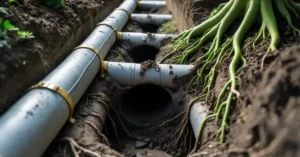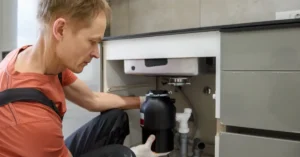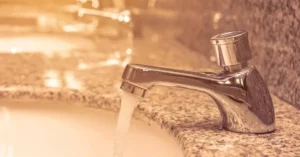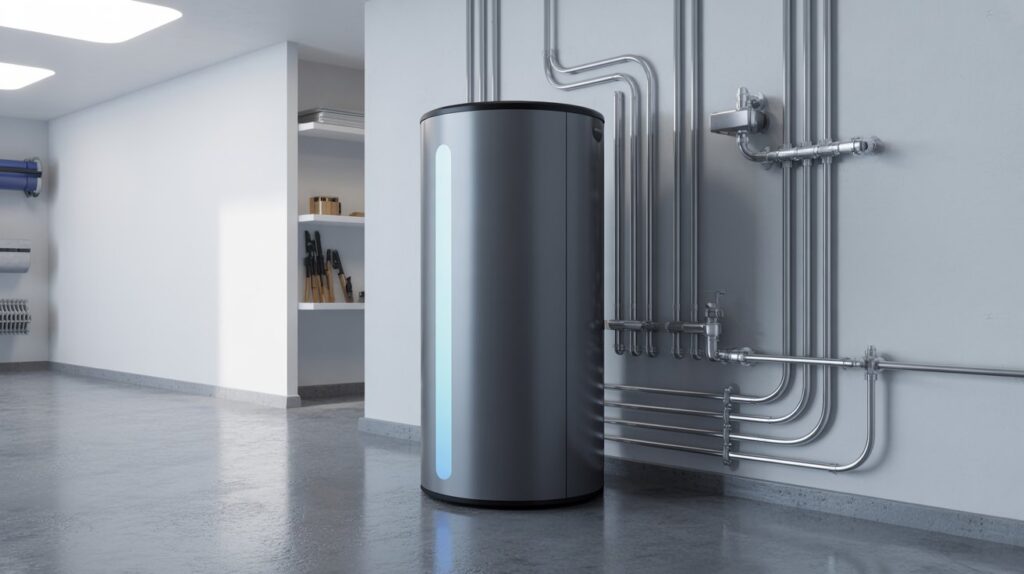
If your old water heater is giving up or you just want lower energy bills, a heat pump water heater is a smart choice. These units are highly efficient and can cut down your monthly hot water costs. This detailed guide will show you how to install a heat pump water heater safely and correctly, covering everything from electrical needs to plumbing connections.
A heat pump water heater, also known as a hybrid water heater, does not create heat in the same way a standard unit does. Instead, it moves existing heat from the surrounding air into the tank. This process is much more efficient than using electric resistance heating elements alone, making it a great investment for homeowners.
What Is a Heat Pump Water Heater?
A heat pump water heater, or hybrid water heater, is a highly energy-efficient alternative to traditional electric tank models. It’s an appliance that uses a refrigeration cycle to transfer heat. Think of it like a refrigerator, but working in reverse.
Instead of creating heat, the unit pulls warmth from the air around it. It then transfers this heat into the hybrid hot water tanks to warm the water. This process requires very little electricity, which is why these systems are so energy efficient. Most models are “hybrid,” meaning they also include standard electric resistance heating elements. These elements kick on only when the demand for hot water is very high. This makes sure you never run out of warm water, even during times of heavy use.
How Heat Pump Water Heaters Work
Understanding how these units function is key to a successful heat pump water heater installation. The process involves three main parts:
- Air Intake: A fan draws in air from the surrounding room a basement or garage, for example.
- Heat Extraction: This air passes over an evaporator coil. The refrigerant inside this coil absorbs the heat from the air. Even air that feels cool contains heat.
- Heat Transfer: The now-heated refrigerant moves through a compressor. This increases its temperature and pressure greatly. The super-heated refrigerant then runs through a condenser coil, which is immersed in the water tank. The heat transfers from the coil to the water, warming it up.
- Cool Air Exhaust: The air that has had its heat removed is blown out of the unit. This exhaust air is cool and dry, which is why these units often work best in areas that are already somewhat warm or have good ventilation.
Because the system simply moves heat instead of generating it, it uses significantly less electricity. This is what makes the hybrid water heater installation so appealing
How Much Does It Cost to Install a Heat Pump Water Heater?
The cost to install a heat pump water heater varies widely based on whether you do it yourself or hire a professional, and the complexity of your current plumbing and electrical setup.
As of 2025, the average cost range for a professional heat pump water heater installation is typically $3,200 to $4,700.
Cost Factor | Average Price Range | Notes |
Unit Cost (Tank & HP) | $1,500 to $3,500 | Depends on the size (e.g., 50-gallon, 80-gallon) and brand. |
Professional Labor | $1,500 to $2,500 | If converting from gas or an older system, labor costs increase due to new plumbing and electrical work. |
New Electrical Circuit | $500 to $1,500 | Needed if you do not already have a dedicated 240V, 30-amp circuit. |
Condensate Pump/Drainage | $100 to $300 | If no floor drain is nearby. |
Permits & Inspection | $50 to $300 | Varies by location. |
While the upfront cost is higher than a standard model, the energy savings mean the unit typically pays for itself in 3 to 5 years. Look into federal, state, and local rebates, as these can lower your final purchase price significantly.
How to Install a Heat Pump Water Heater: Step-by-Step Diagram & Guide
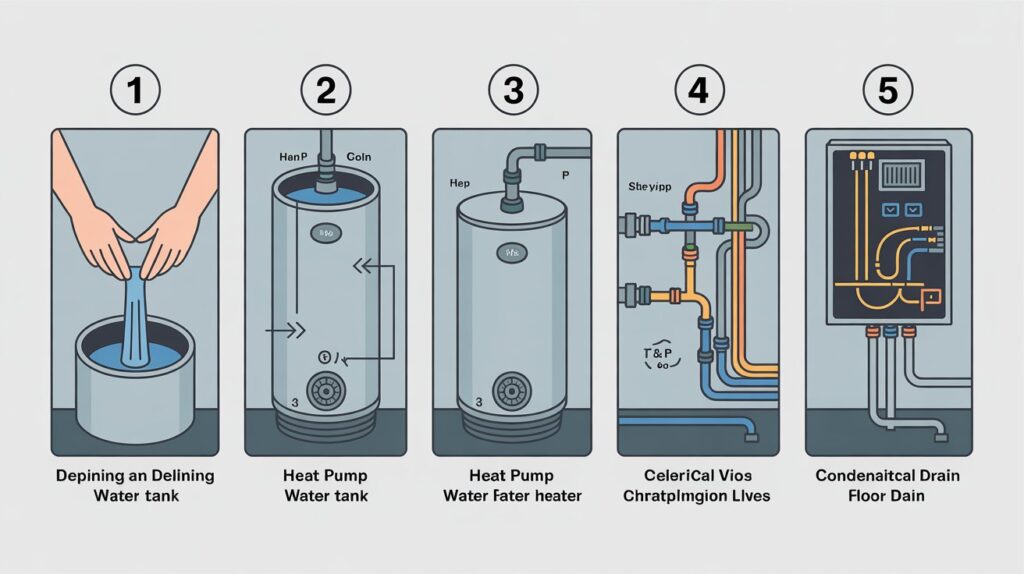
This is a general guide for replacing an existing electric tank. Always follow the specific instructions in your model’s manual. For complex steps, especially the 240V wiring, hire a licensed pro.
Step 1: Safety First—Remove the Old Unit
- Turn Off Power: At your main electrical panel, turn off the breaker for the old water heater. Use a voltage meter to confirm no power is running to the unit.
- Turn Off Water: Close the cold-water inlet valve at the top of the old tank.
- Drain the Tank: Connect a garden hose to the drain valve at the bottom of the old tank. Route the hose to a safe drain (like a floor drain or outside). Open the drain valve and open a hot water tap in your house to let air in, which speeds up the draining.
- Disconnect: Once empty, disconnect the old water lines and the electrical wiring (again, only do this if you are qualified).
- Remove: Carefully move the old water heater out of the way.
Step 2: Position the New Unit
- Placement: Place the new unit in its final location. Make sure you meet all the clearance requirements.
- Level: Use a level to ensure the unit sits flat. If your floor is uneven, adjust the leveling feet on the bottom of the unit. This is important for proper drainage and performance.
- Drain Pan: If local code requires it, place a drain pan beneath the unit and connect it to a drain line.
Step 3: Plumbing Connections
- T&P Valve: Install the Temperature and Pressure (T&P) relief valve into the side or top of the tank. This is a crucial safety device.
- Water Lines: Connect the cold-water supply line to the tank’s cold inlet and the hot water outlet line to the tank’s hot outlet. Use flexible copper or braided steel connectors for an easier and more reliable connection that reduces vibration noise. Use dielectric unions to connect copper piping to the tank’s steel nipples; this prevents corrosion.
- T&P Discharge: Install the discharge pipe onto the T&P valve. It must run to a floor drain or other approved location, terminating a few inches above the floor.
Step 4: Electrical Wiring
Note: If you are not licensed, hire a pro for this step.
- Run Wire: Run the necessary wire (usually 10-gauge) from your 240V, 30-amp dedicated circuit breaker to the unit’s electrical junction box.
- Connect: Follow the wiring diagram exactly. For example, when you install a Rheem heat pump water heater, the manual will show the specific terminals for the black, red, white (if used), and green (ground) wires. Make sure all connections are tight.
- Close Up: Securely close the junction box cover.
Step 5: Condensate Management
- Condensate Drain: Locate the condensate drain port on the unit.
- Drain Line: Attach a plastic or copper drain line and run it toward a floor drain. Ensure the line runs downhill the entire way for proper gravity drainage.
- Condensate Pump (If Needed): If the unit is below the drain location, install a condensate pump. The drain line runs into the pump, and a separate line runs from the pump to the main drain.
Step 6: Final Startup and Testing
- Fill the Tank: Slowly open the cold-water inlet valve. Open a hot water faucet in your house to let the air escape from the pipes. When water flows steadily from the faucet, the tank is full. Close the faucet.
- Turn On Power: Flip the circuit breaker back on at the main panel.
- Initial Check: Follow the manufacturer’s instructions to start the unit. This usually involves selecting the “Heat Pump Only” or “Hybrid” mode on the control panel.
- Test T&P Valve: Gently lift the lever on the T&P valve to verify water flows out of the discharge pipe.
- Check for Leaks: Inspect all plumbing connections and the condensate line for any leaks.
How to Install a Rheem Heat Pump Water Heater
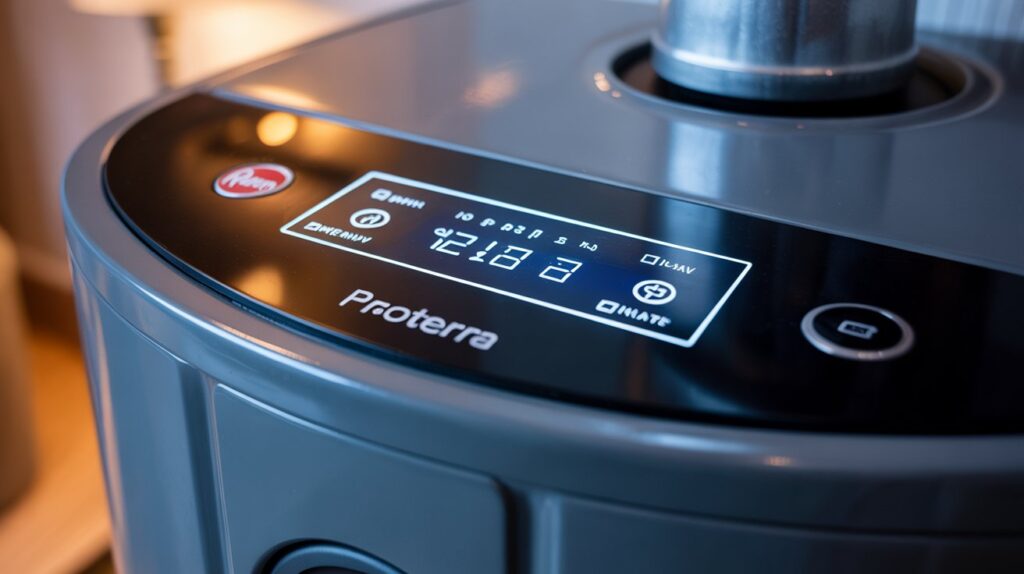
Rheem’s ProTerra line of hybrid hot water tanks is a very popular choice. The general steps above apply, but here are specific details to ensure a perfect installation:
- Ducting: Rheem ProTerra models are often designed with optional ducting kits. If you are doing a how to install a heat pump water heater in small space project, you must duct the exhaust air out of the tight room. The manual will show you the maximum duct length.
- Voltage: The standard 50-gallon and 80-gallon models use a 240V circuit. However, Rheem also offers a 120V “Plug-in” model designed to replace gas units, which requires less intense electrical work but may need more air volume. Always verify your specific model’s requirements.
- Leak Protection: Many Rheem ProTerra units come with a built-in LeakGuard detection system. This feature adds peace of mind and simplifies the installation compared to adding an external leak sensor.
Converting from Gas to Electric Heat Pump
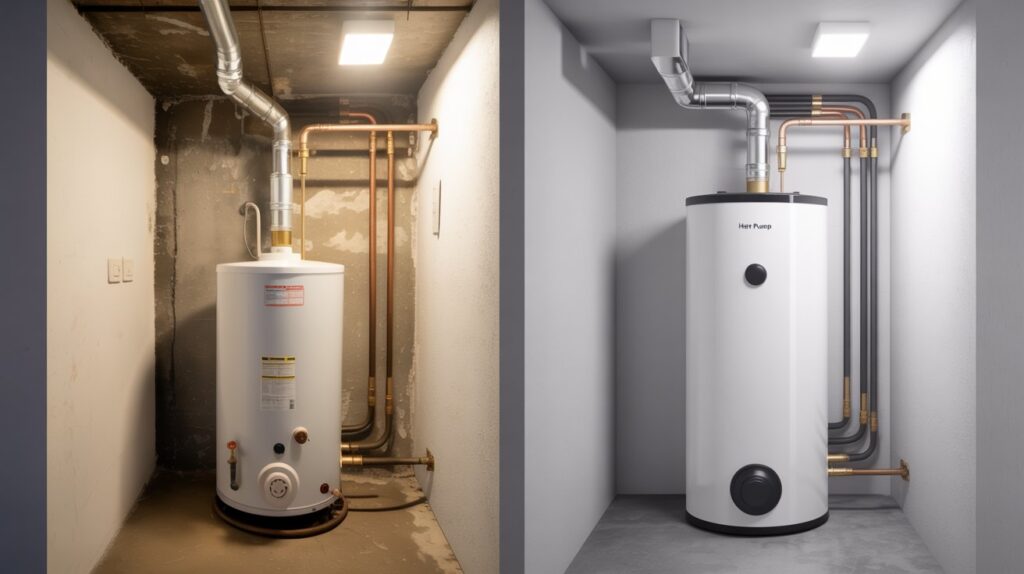
Replacing a gas unit with a hybrid electric unit involves extra steps because of the different fuel sources.
- Gas Line Disconnection: A qualified plumber or HVAC technician must safely shut off the gas supply and cap the gas line. This requires extreme care.
- Vent Removal: Gas units have a flue vent to exhaust combustion byproducts. The vent must be removed and the opening safely sealed or repurposed.
- New Electrical Circuit: You must install the dedicated 240V electrical circuit, which was not needed for the old gas unit.
This conversion process is highly complex and is not a good DIY project. It should be handled by a professional plumbing and HVAC company like Derks Plumbing.
How to Install Heat Pump Water Heater in Small Space
If your chosen location, like a small closet or utility room, does not meet the minimum 700 cubic feet of air space, you still have options for a successful heat pump water heater installation:
- Ducting: This is the best solution. Duct the cold exhaust air from the unit out of the small room and into a large, unconditioned space like an attic or another garage. This allows the unit to constantly pull in fresh, warmer air from the area around the closet or through a louvered door.
- Louvered Door: Replace the solid closet door with a fully louvered door. This provides the continuous air exchange needed for the unit to function. A louvered door, combined with a duct heat pump water heater system, can ensure proper airflow even in tiny areas.
- Air Grilles: Install high and low transfer grilles into the walls of the closet to allow air to circulate from an adjacent room.
The goal is to ensure the unit always has enough warm air to “pump” heat from.
You can read about: How to Install Tankless Water Heater
Conclusion
Installing a heat pump water heater is a valuable upgrade that can provide years of energy savings and reliable hot water. While the process of how to install a heat pump water heater involves careful plumbing and electrical work, a thorough understanding of the requirements makes the job manageable, especially for a homeowner with a strong DIY background. Always prioritize safety, follow the manufacturer’s directions, and ensure you meet all local code requirements.
If the job seems too complicated, or if you need help with electrical work or converting from a gas line, don’t hesitate to reach out to a trusted professional. For expert Water Heater Installation Eagle Rock and surrounding areas, the team at Derks Plumbing is ready to help you with your new, high-efficiency hybrid unit.
FAQs
Q1: Can I install a heat pump water heater outside?
In most cases, no. Most hybrid units are designed for indoor use. They need to be in a space that stays above 40°F (4°C) year-round to be efficient. Placing them outside in a cold climate will make them rely only on the less efficient electric resistance backup heating elements, defeating the purpose of the high-efficiency unit.
Q2: How long does a heat pump water heater installation take?
A simple replacement of an existing electric water heater with a new hybrid water heater installation takes a professional about 4 to 8 hours. Converting from a gas unit or needing a new 240V circuit can take a full day or more, especially when waiting for electrical inspection.
Q3: What is the benefit of a hybrid hot water tank over a standard tank?
The main benefit is energy efficiency. A hybrid unit uses the heat pump to move heat from the air, making it 2 to 3 times more efficient than a standard electric unit that uses only heating elements. This saves you a significant amount on your monthly electric bill.
Q4: Does a heat pump water heater make a lot of noise?
They are louder than a standard electric unit, but not by much. They usually make a low hum, similar to a dishwasher or an air conditioner running. This is why it’s best to install them in a basement, garage, or utility room away from living and sleeping areas.

